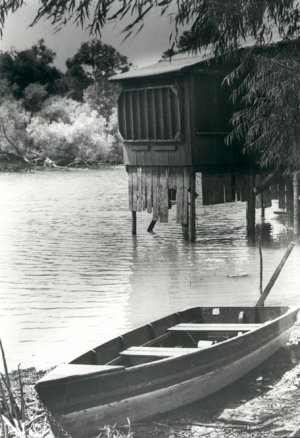|
Until the war years, private individuals, businesses and organizations erected a number of buildings on White Rock's shores. Most conspicuous were the approximately 250 private campsites, boathouses and fishing shacks located in various places along the shoreline. Several individually owned structures actually predated the establishment of the park, built under agreements made with the City Water Board. Constructed on land leased from the city for $25 a year, these oftentimes-ramshackle wooden shelters were viewed by some Dallas residents as eyesores. Most, however, were situated on the eastern shore, far from residential areas where they could cause offense to the sensibilities of Dallas elites. (Although there were also several clustered along the shore of the inlet just north of the filtration plant, across from the municipal boathouse.)
Because they lacked running water or electricity, the lessees were not permitted to use their shacks as permanent dwellings. During the Great Depression, however, the city reportedly turned a blind eye whenever individuals down on their luck violated this restriction. A number of private boat docks and concession stands, on which the city also collected rents, were permitted in the park as well.
Although there had been some talk of it earlier, it wasn't until the summer of 1939 that city officials began to seriously look askance at their policy of permitting privately owned structures on public property, approving a plan that called for the gradual removal of such buildings. Foremost among the plan's supporters was former Mayor Joe E. Lawther, who "urged citizens to back the program to the limit." "Dallas is a city of 300,000 people," said Lawther in defense of the city's position, "and unless there is sufficient space at White Rock to provide camp sites for all who are financially able and desire such sites, those who have them are privileged." "The entire citizenry," he added, "should be permitted to enjoy all the facilities of a city-owned park." It just wasn't right, argued Lawther, that people "who have rented these sites at $1 a front foot a year" should enjoy "a beautiful lake front home" at such a low cost and "with no tax paid to the city, state, or county."
In late July 1939 the city began implementing the plan by having its legal department prepare orders for "nine owners of camps and boathouses to remove buildings from city land immediately." The nine individuals affected were chosen because they "did not pay the annual ground rental after repeated warnings," remarked The Dallas Morning News, adding, "they are likely to be the first of many such edicts to be issued in the general cleanup plan." Over the next few years, all the shacks and campsites were eventually removed, with the exception of a handful of property-owners who managed to keep their leases until the end of World War II. Although the removal of these structures surely improved the lake's scenery as well making more of the shoreline accessible to all park visitors, it also resulted in a substantial decrease in Park Board revenues.
|

Photo courtesy Jay Firsching of Architexas and the Dallas Park and Recreation Dept.
Sources:
Dallas Morning News, July 29, 1939.
Harry Jebsen, Jr., Robert M. Newton, and Patricia R. Hogan, Centennial History of the Dallas, Texas Park System, 1876-1976 (Lubbock, Texas: Texas Tech University, 1976), 439 & 518.
|
